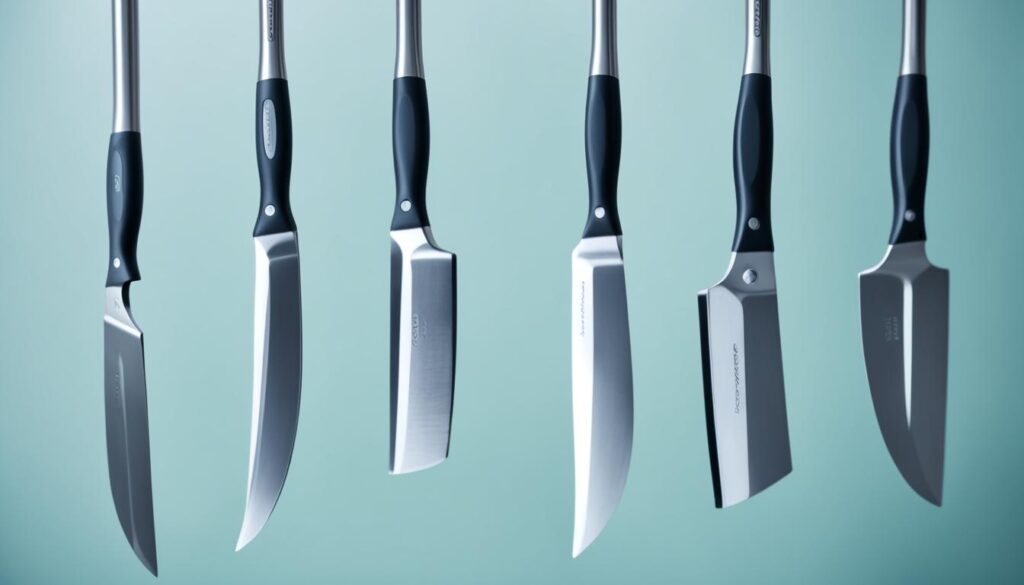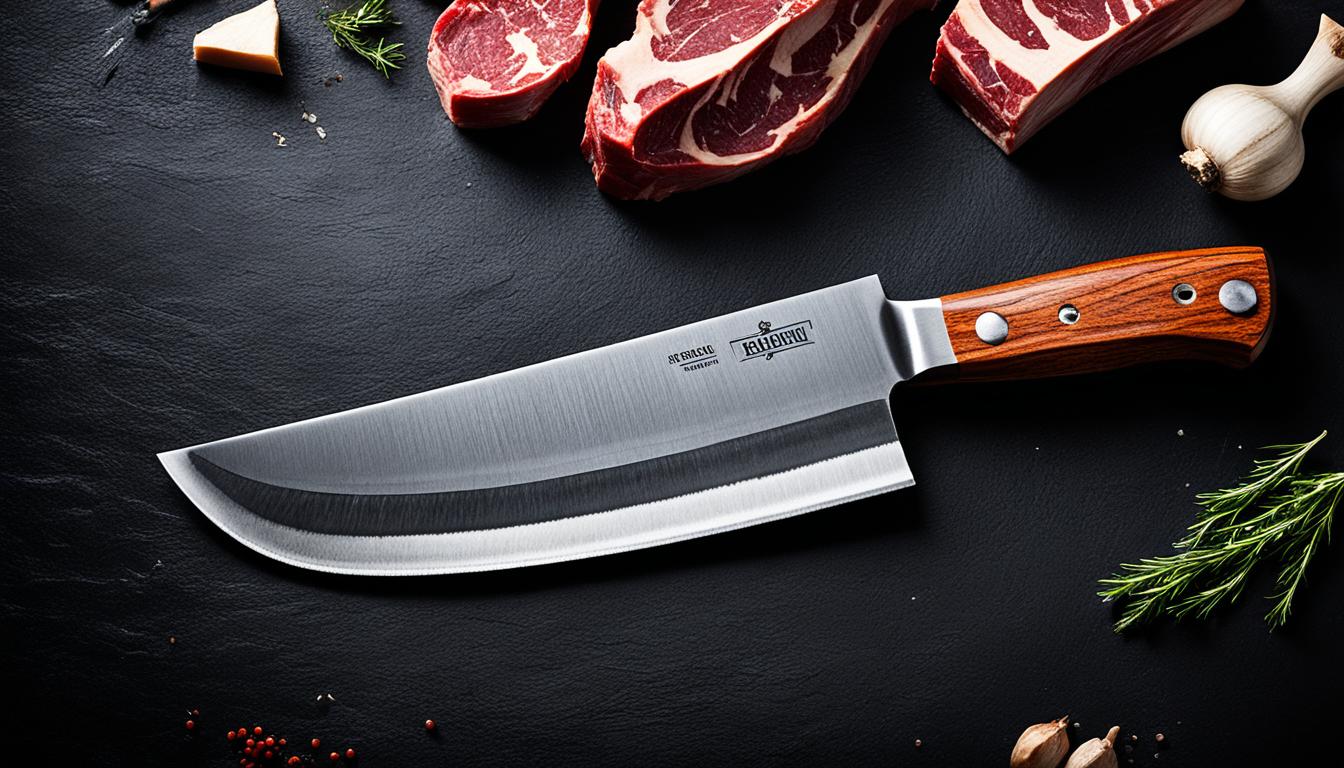Are you a fan of succulent cuts of meat or a master of the kitchen? If so, then you’ve probably heard of meat cleavers. But did you know that these versatile tools have applications beyond the butcher shop? Whether you’re a professional chef or an avid home cook, understanding how to choose, buy, and care for a meat cleaver is essential.
Key Takeaways:
- Meat cleavers are large knives designed for slashing through thick pieces of meat.
- A good meat cleaver offers benefits such as easier and safer food preparation.
- There are different types of cleaver knives available, including meat cleavers, Chinese cleavers, and vegetable cleavers.
- When picking the best cleaver knife, consider factors like sharpness, material, and design.
- Caring for your meat cleaver involves proper cleaning and maintenance techniques.
The Benefits of a Good Cleaver
Using a good cleaver in the kitchen brings numerous advantages, making it an essential tool for every home cook. Whether you’re a professional chef or an amateur enthusiast, investing in a high-quality cleaver can greatly enhance your culinary experience.
Easier Food Preparation
A good cleaver is designed to effortlessly cut through tough meats, such as bone-in cuts and large roasts. Its sturdy and sharp blade allows you to make precise cuts, reducing the overall effort required during food preparation. With a well-balanced cleaver, you can swiftly separate meat from bone, trim fat, or chop vegetables with ease.
Safer Handling
One of the key advantages of using a cleaver in the kitchen is improved safety. The weight and size of a cleaver provide stability and control, minimizing the risk of accidents while cutting through tough ingredients. Additionally, a good cleaver often features an ergonomic handle, ensuring a comfortable grip and reducing hand fatigue during prolonged use.
Versatility in Cooking
Besides its primary function of butchering meats, a versatile cleaver can handle a variety of tasks in the kitchen. From smashing garlic cloves to crushing spices, a cleaver can serve as a multipurpose tool, eliminating the need for multiple knives or specialized equipment. Its broad flat side even makes it ideal for transferring chopped ingredients from the cutting board to the pan.
“Using a good cleaver not only enhances efficiency in the kitchen but also allows for greater creativity in culinary endeavors.”
Durability and Longevity
A well-crafted cleaver is built to withstand the demands of heavy-duty use. With a durable blade made from high-quality materials like stainless steel or carbon steel, a good cleaver retains its sharpness for extended periods, reducing the need for frequent re-sharpening. Additionally, proper care and maintenance can ensure its longevity, making it a reliable companion in your cooking journey for years to come.
Time-Saving Tool
Investing in a good cleaver can significantly speed up your food preparation process. Its powerful cutting ability allows you to accomplish tasks quickly, saving valuable time in the kitchen. With a sharp and efficient cleaver, you can spend less time struggling with tough ingredients and more time enjoying the cooking process.
Overall, the benefits of a good cleaver in the kitchen are undeniable. It offers easier food preparation, safer handling, versatility in cooking, durability, and time-saving qualities. By having this essential tool at your disposal, you can elevate your culinary skills and create delicious meals with confidence.
Types of Cleaver Knives
When it comes to cleaver knives, there are several different types available, each designed for specific tasks. Whether you’re a professional chef or a home cook, understanding the various types of cleavers can greatly enhance your culinary experience.
One popular type of cleaver knife is the meat cleaver. As the name suggests, meat cleavers are primarily used for cutting and chopping meat. With a thick, heavy blade, these cleavers can easily break through bones and handle tough cuts of meat with ease.
Another commonly used cleaver is the Chinese cleaver, also known as a Cai Dao. This versatile cleaver is known for its thin and lightweight design, making it ideal for precise slicing and dicing of vegetables. The wide blade also allows for efficient scooping and transferring of ingredients.
For those who love experimenting with plant-based dishes, the vegetable cleaver is a must-have in the kitchen. This cleaver is specifically designed for cutting and preparing various types of vegetables. The thin blade and intricate design enable easy maneuverability, allowing for precise cutting and shaping of vegetables.
“The right cleaver can make a world of difference in the kitchen. Knowing which type of cleaver to use for different tasks can significantly improve your efficiency and overall cooking experience.”
Here’s a table detailing the key features of each type of cleaver knife:
| Type of Cleaver Knife | Primary Use | Blade Thickness | Weight |
|---|---|---|---|
| Meat Cleaver | Cutting and chopping meat | Thick | Heavy |
| Chinese Cleaver | Slicing, dicing, and scooping | Thin | Lightweight |
| Vegetable Cleaver | Cutting and shaping vegetables | Thin | Varying weights |
Now that you’re familiar with the different types of cleaver knives, you can choose the one that best suits your needs and elevate your culinary skills to new heights.
How to Pick the Best Cleaver Knife
\
When it comes to selecting the perfect cleaver knife for your needs, there are several key factors to consider. The right combination of sharpness, material, and design can make a world of difference in your cutting experience. Let’s explore how to choose the best cleaver knife that suits your culinary needs.\
\
Sharpness\
\
One of the most important aspects of a cleaver knife is its sharpness. A well-honed edge ensures efficient cutting and reduces the effort required for slicing through tough meats and dense vegetables. Look for a cleaver knife with a razor-sharp blade that retains its sharpness over time. A blade with a high Rockwell hardness rating will provide excellent edge retention.\
\
Material\
\
The material of the cleaver knife blade is another crucial consideration. Stainless steel and carbon steel are popular choices due to their durability and resistance to rust and corrosion. Stainless steel offers easy maintenance and is great for everyday use, while carbon steel provides exceptional sharpness and edge retention. Consider your specific needs and preferences when choosing the material for your cleaver knife blade.\
\
Cleaver Knife Design\
\
The design of the cleaver knife plays a significant role in its functionality and comfort. Look for a cleaver with a well-balanced weight distribution between the blade and handle, ensuring ease of handling and control. Ergonomically designed handles provide a comfortable grip, reducing fatigue during prolonged use. Additionally, a full tang construction, where the blade extends through the handle, offers enhanced stability and durability.\
\
| Feature\ | Advantages\ |
|---|---|
| Sharpness\ | – Efficient cutting\- Reduced effort required\ |
| Material\ | – Durability and resistance to rust and corrosion\- Easy maintenance (stainless steel)\- Exceptional sharpness and edge retention (carbon steel)\ |
| Design\ | – Well-balanced weight distribution\- Comfortable grip\- Enhanced stability and durability (full tang construction)\ |
\
By considering these essential factors, you can confidently choose the best cleaver knife for your kitchen. Remember to prioritize sharpness, select a suitable blade material, and opt for a design that ensures comfort and functionality. Happy cooking!\

Conclusion
In conclusion, choosing and caring for a meat cleaver requires careful consideration of several important specifications. The blade material is crucial, as it determines the cleaver’s durability and sharpness. Opting for stainless steel or high carbon steel ensures longevity and exceptional cutting performance. Additionally, the handle design plays a significant role in comfort and grip, with options ranging from traditional wooden handles to modern synthetic materials.
Another crucial factor to consider when selecting a meat cleaver is the size. Different tasks may require different sizes, and it’s essential to find a cleaver that suits your specific needs. While a larger cleaver offers more power and leverage, a smaller one provides enhanced maneuverability for delicate tasks.
Once you have chosen the perfect meat cleaver, proper care and maintenance are vital to maximize its lifespan. Regular cleaning, drying, and storing it safely will help prevent rust and maintain its sharpness. Remember to always follow the manufacturer’s instructions for sharpening and storage. By considering these specifications and maintaining proper care, you can enjoy the benefits of a well-chosen and well-maintained meat cleaver for years to come.
FAQ
How do I choose the right meat cleaver?
What are the benefits of using a good cleaver in the kitchen?
What types of cleaver knives are available?
How do I pick the best cleaver knife?
How should I care for my meat cleaver?
Source Links
- https://www.linkedin.com/pulse/how-choose-use-best-meat-cleaver-knife-your-kitchen-josh-smith-zsizc?trk=article-ssr-frontend-pulse_more-articles_related-content-card
- https://www.shanzuchef.com/blogs/chef-blog/the-complete-guide-to-cleavers-choosing-and-using-the-best-cleaver-knife
- https://designasausage.com/the-essential-guide-to-choosing-and-using-meat-cleavers/
